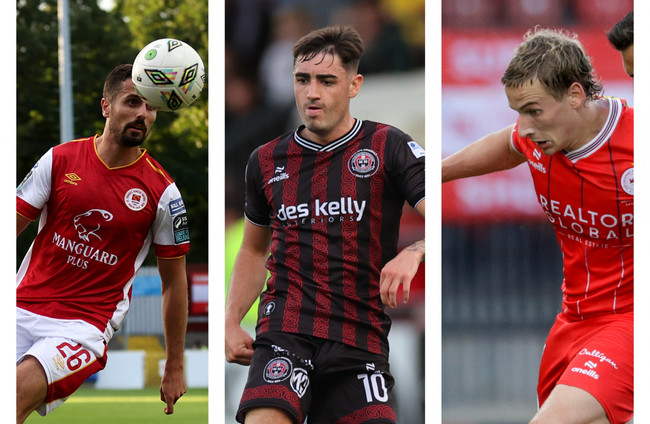THERE WAS A point towards the end of this summer transfer window when at least one League of Ireland club felt they were close to signing an experienced operator from England’s Football League.
The player in question had featured in the three divisions below the Premier League (predominantly the Championship) over the last decade.
A basic weekly wage in the region of €1,500 had been agreed with further add-ons for appearances, end-of-season league placing, European qualification and FAI Cup success. Accommodation costs for relocating were also part of the package.
The deal looked set to get over the line.
Then came the late curveball.
The add-ons could be scrapped, the player’s camp said, but he now wanted more than €5,500 a week basic.
He had heard about the supposed boom in the League of Ireland and was the one who actively sought out to test the waters.
The Premier Division was never previously on his radar and once those demands were put forward the deal was dead.
The brutal truth, as one source put it, is that for 99% of players based in the United Kingdom, who have no link to Ireland or past experience in the league, this remains “Option Z” when it comes to their future.
The market the League of Ireland really operates in is a small one, with modern scouting structures in Britain and further afield in Europe basically non-existent and relying on agents and “old-school connections”.
Wages and contracts are improving but not to the extent whereby a raft of players in the bottom tiers of English football or even the lower end of top level in Scotland would view it as a worthwhile move.
But the words of Cork City boss Tim Clancy, who was speaking not long before the First Division league leaders were eventually able to offer Ruairi Keating a strong enough financial package themselves to make it worthwhile for the striker to push for a move away from St Patrick’s Athletic after a few weeks of talks, piqued the interest of some.
“You have conversations with players that you would like to sign but we have to be realistic with where we’re at,” Clancy said last month.
“The wages that are being paid in the Premier Division at the minute are through the roof. You would question the sustainability of that over a long-term period.
“You have clubs that are nowhere near European positions paying two, two and a half, three grand a week to players that won’t be able to get Europe next season.
“We aren’t in the position to go and compete with clubs that are paying massive, massive wages which is happening in the Premier Division.”
Clancy would no doubt be aware of going rate for certain individuals given he can safely plan for next season in the top flight. Cork have been in talks with former Ireland international and Preston North End striker Seani Maguire over the last few weeks.
It has been known for much of the summer that the 30-year-old would be available and perhaps the figures quoted by Clancy helped him reach an assessment of the current state of play.
Others at the top of the Premier Division have not been enticed by the prospect of bringing Maguire due to the cost of the deal. Cork, it’s understood, remain interested – and the nature of the window means that even though League of Ireland clubs cannot sign under contract players until January, the market is still open for another month.
Salaries in the Premier Division are rising rapidly, just as revenue from increased attendances and improved commercial/sponsorship deals also increase.
This is all without any significant income from broadcasting rights. Virgin Media and RTÉ show games live and while they do contribute a rights fee, it is paid to FAI and understood to not be a significant figure that is then redistributed within prize money.
There is a small amount of income from LOI TV, while across the water in England, EFL clubs are benefitting from a record domestic rights deal with Sky Sports worth £895m in guaranteed payments over a five-year period, with an annual average of £179m.
For example, Carlisle United, who Maguire was released by at the end of last season, will earn a minimum of £300,000 per season in League Two.
Sources explained how certain clubs here drove this most recent domestic summer transfer market, the feeling being it’s for the rest to catch up or be creative in how they bridge the gap.
Some are unsure of how sustainable it is because they have been surprised by just how aggressive some clubs were and what they were able to do financially.
Contracts are longer, bonuses are bigger, and it’s understood that agents are now expecting fees for certain deals where they wouldn’t have previously.
This, though, feels in line with the assessment across the board that club officials, players and agents generally need to act more professionally.
Conjecture is a constant, with sources detailing examples of figures from clubs, even within the FAI, adding to the rumour mill.
“Everyone loves to moan and gossip about what everyone else is doing and throw around figures, it’s embarrassing at times,” one source said.
The higher bracket of wage, upwards of €2,500 a week, is certainly growing but the number of players commanding those fees appears to be manageable.
At least two signings this summer were able to secure such deals in that ballpark, while Shamrock Rovers would have a few members of its first-team squad earning more than that again.
The average wage for a full-time player is estimated to be in the region of €700 a week, while since the start of this season the implementation of the minimum wage standard means no professional aged 20 or over is earning less than €22,360 annually.
There is a tiered system, with a 19-year-old’s salary starting at €19,760, €17,160 for an 18-year-old, and €14,560 for those 16- and 17-year-olds.
Deductions of €100 (up to a maximum of €5,000) are allowed in each instance for those clubs paying players’ accommodation costs and for education.
The bigger issue is balancing the bracket of earners who would have been on around €500-900 previously but now seek a hefty increase.
As one source bluntly put it: “I don’t know if the quality of the player in the league is improving as quickly as the wages. You’ve got players coming in on [English] League 1 contracts. Hopefully it allows us to keep and protect our best players a little bit longer but I do worry a bit about how sustainable it is.”
Given that the FAI must sign off on budgets for clubs, in line with licensing requirements, there are checks and balances in place to ensure mistakes of the past are not allowed.
And while Cork (Jake O’Brien), Bohemians (Promise Omochere) and Shamrock Rovers (Sinclair Armstrong) will be sharing an unexpected windfall in the region of €1.5 million due to sell-on clauses for former players, they cannot simply spend at will as budgets are approved from an average of a few years rather than simply off one strong financial year.
Rovers, for example, recorded a loss of €2.4m for 2023 after a profit of €1.57m the year beforehand and success in Europe this year has guaranteed in the region of €1.8m from UEFA, with additional commerical bonuses and gate money bolstering that further. The home leg of the Champions League tie with Sparta Prague led to a record European attendance of 9,684 at Tallaght Stadium and a minimum of two more home games are guaranteed.
The PFAI will also point out that they have not had any issue with a club in the six years since Bray Wanderers were sanctioned by the FAI for unpaid wages to its squad.
Further to this, the new FAI Connect app means there is now a centralised online system for clubs to upload contracts. They submit the details, inform officials in the league’s offices and then await for confirmation that it has been received and accepted.
The recent transfers of Harry Wood, Dawson Devoy, Ross Tierney, Zack Elbouzedi and Aidan Keena are prime examples of how the League of Ireland market operates.
All of those players returned to these shores after spells at Shelbourne, Bohemians, Waterford and Sligo Rovers, respectively.
When Wood was made available permanently by Hull City, Shels re-entered the race to sign him. They had stiff competition from Bohs and, even though the Tolka Park club have benefitted from an estimated cash injection of €1m since new investment earlier in the year, they struck a deal within their current wage structure that made the Englishman one of their higher earners but still falls below the highest bracket for the league as a whole.
Bohs have certainly been “aggressive” in the market, as have St Pat’s, as was explained earlier, and they also beat the Saints to the signature of Devoy with a deal that ensured the former MK Dons midfielder would be in the highest bracket of earner, along with Tierney who was another who opted to re-join the Gypsies after spells with Motherwell and Walsall.
In an interview with The 42 last week the pair acknowledged their standing in the pecking order. “I’m not coming back to chill,” Tierney said. “Neither of us are. Yeah, we are getting paid well and we get it off the rest of the lads in the dressing room everyday about it.
“We know the standards we’ve set and if we do something wrong, we will get it. We’ve set a bar and lads expect us to raise standards so that’s what we’ve got to do.”
Bohs are attempting to do the same and, as a fan-owned club, must do so prudently, especially given how close they came to the financial abyss previously.
They attempted to hijack Pats’ deal for Keena at the back end of last week when it emerged that Stephen Kenny’s side had intensified their attempts to get him over the last 10 days.
Circumstances with Keating, who pushed for a move back to Cork, also gave Pat’s the added advantage of being able to get one of their highest earners off the wage bill and bring in a replacement costing less in wages.
Bohs and Sligo Rovers had been monitoring Keena’s situation at Cheltenham Town but were put off by the demand for a transfer fee for a player who was their record signing in January 2023.
Pat’s eventually got a deal over the line that didn’t require a fee, and the 25-year-old arrived at Inchicore not long after former Republic of Ireland U21 international Zack Elbouzedi was enticed back following a spell with AIK Stockholm in Sweden.
They are the most high-profile deals of the window but indicative of a transfer market that is still largely insular and one of the bottom rungs on the ladder.












Great news especially with rojo being able to cover left full and centre half . Unfortunately the damage is already done for the league this season
@hard yaka: yeah hard yaka can’t see city being caught but great to have the 3 of them back.
Pogba will be a huge addition. He’s been a massive loss. As somebody who never rated Herrera, I’m glad the rest of the Utd fans have finally copped how limited he is.
@Lurfic: Most be you only man and a handful of others. I highly rate Herrera and quite a lot of united fan base too.
Herrera is a work horse, future captain I think.
Great news. Pogba is back. Hahahah brillo. Points be dropped even more so now.
@Is mise muc gránna: what’s that comment based on that doesn’t make any sense united have dropped more points without him playing so what sort of comment is that?
@John Barnes: Don’t feed the semiliiterate troll John.
@John Barnes: Because he actually hasn’t a clue what he is saying, just ‘attempting’ to be funny and kick off another war of words by muttering any old shit.
@Declan Doyle: that would be semiliterate……
@Jason Brosnahan: That’s correct. Careful or they’ll be after you also.
@John Barnes: The point is that in my opinion he is rubbish so great and brillo he is back.
@Is mise muc gránna: who actually says “brillo”? What are you 7 ?
@Is mise muc gránna: Know when you’re beaten. Shut it.
Happy days
Delighted to have them back especially Rojo the guy is a beast and a brick wall.
Yawn. So overvalued and over rated. Better than the crap playing at the moment to be fair though